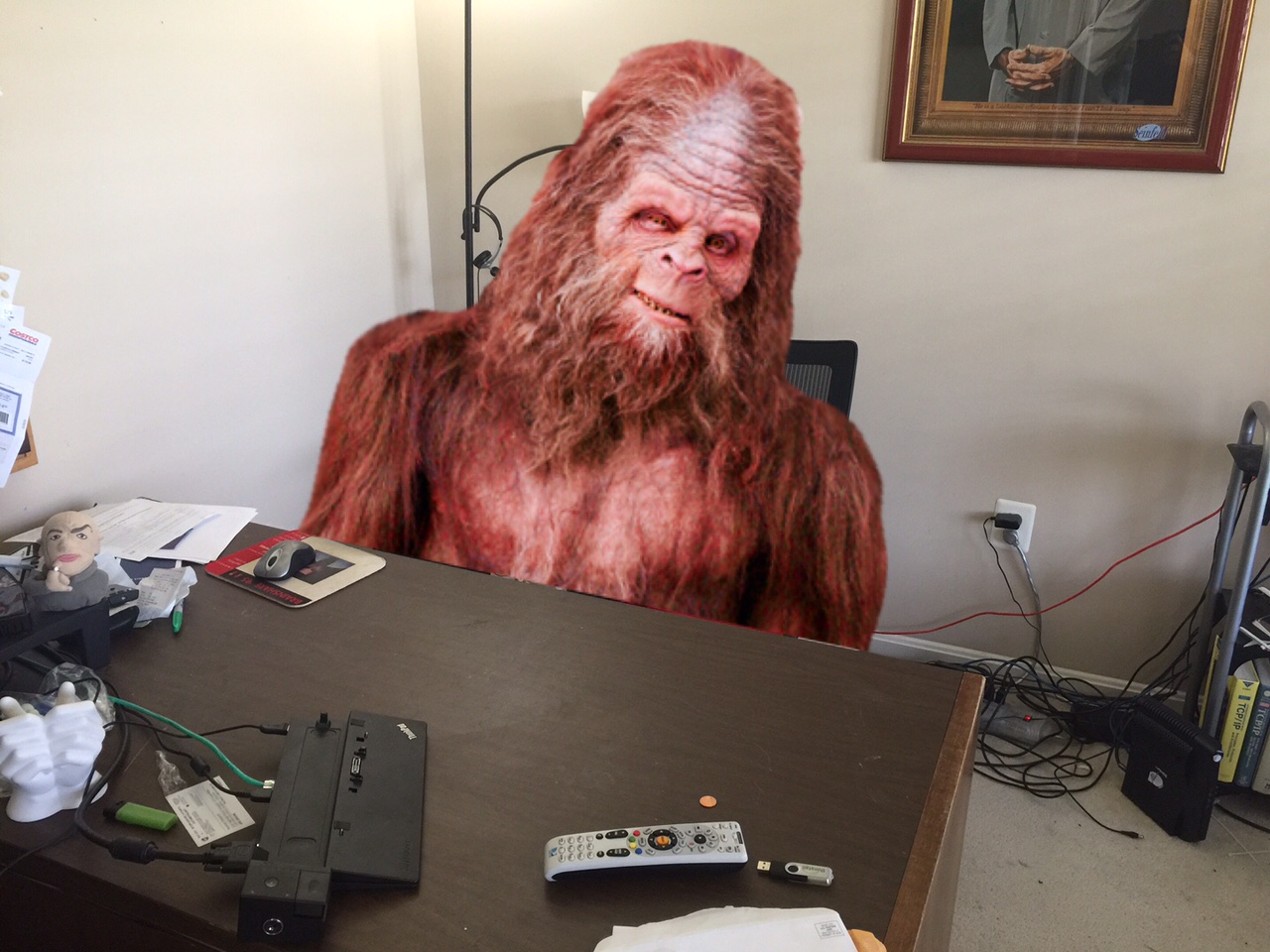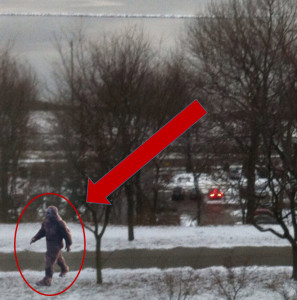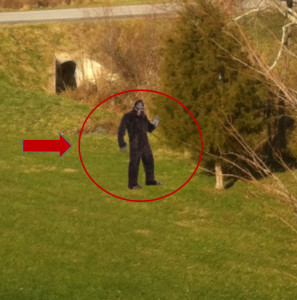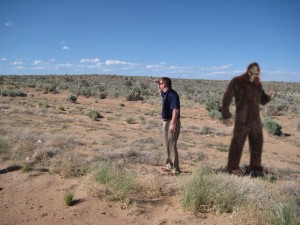One dark cold night, three men are quietly sitting deep in the woods, somewhere in the Appalachian mountains. They listen intently to every noise, then from a distance they hear a sound that could resemble the creature they are seeking—Bigfoot. One of the men jumps up, takes a deep breath, and with all his strength lets out a sickening howl that sounds like he is part screaming and part singing. Meanwhile, at a campsite a couple of miles away, a group of young adults are sitting around a campfire. They hear what sounds like a man screaming in the distance. A young man sitting by the fire and under the influence of alcohol, jumps up, takes a deep breath, and lets out a scream in an effort to mimic the sound he just heard. Upon hearing a scream off in the distance, the three Bigfoot hunters stare at each other, eyes wide open. One of the men says, “It’s a Squatch!”
An IT administrator has finally been able to free up some time to start a very important project. He cleans up his office and calls the warehouse to have someone retrieve the server for him. “What server?” replied the man from the warehouse. “I ordered a server two months ago,” said the IT administrator. “In fact, someone came by my office and told me it had arrived,” claimed the administrator. The man from the warehouse responded, “Are you sure they were talking about the server? Anyways, we will have someone search the warehouse and give you a call back.”
- Marcel Shaw’s Observations – The Bigfoot hunters could probably benefit from scientific equipment while IT administrators will benefit using IT asset management discovery software with B2B and lifecycle tracking capability. If you don’t track your IT assets from the time they are purchased, including a method to document when they arrive, they could go missing.
-Poor discovery techniques lead to confusing conclusions.
- Patricia Adams’ Observations – Having a formalized process that centrally receives all IT assets would assist with tracking. By linking the asset request and purchase order to the shipping info, when the asset is received it can be matched back to the request. When it is stored on the stockroom shelves, using a barcode on the exterior box will automate the manual processes so assets are not easily misplaced after they are entered into the ITAM tool.
The Bigfoot hunters, or Bigfoot scientists as they like to call themselves, decided to document the Bigfoot with a camera. One of the men takes an apple and climbs eight feet into a tree. He takes the apple and pierces it into one of the branches. He positions his camera to capture anything that might come for the apple. The three men leave the area for several hours and return to see that the apple has been taken from the branch. The camera’s battery did not last for more than 30 minutes, which meant they did not capture any video of the apple eater. One of the men looked at the others and said, “Don’t worry about the video, that apple is eight feet up in the tree.” They instantly became excited, looked at each other, and simultaneously said, “Squatch!” Meanwhile, a black crow sits atop a tree not far away enjoying the rest of his fresh red apple.
The IT administrator stopped by the data center in search of his server. While he was there, one of his employees approached him and said, “You know those two virtual servers I told you about a couple of months ago?” “The servers that we don’t know anything about?” said the administrator. “Yes,” replied the employee. “Nobody knows what they are used for and I am afraid to remove them in case they are part of somebody’s project. If we keep them, we will have to pay for the licenses in the upcoming renewal. What do you you me to do?” asked the employee. “Turn them off and wait for the phone to ring,” replied the administrator.
- Marcel Shaw’s Observations – Next time, the Bigfoot hunters should probably focus on making sure that the camera is working before making any conclusions. The servers in the data center are not properly tracked using current asset management processes. Virtual technology has drastically reduced the effort it takes to spin-up a server for projects or testing purposes; however, many organizations have been surprised with unexpected costs as the result of a software audit. Those servers need a license, so organizations need to put discovery procedures in place to ensure virtual servers are tracked when they are created. Be sure to track who it was that spun-up the server and for what purpose. The good news, the IT administrator did not make any assumptions as did the Bigfoot hunters. Shutting down the servers to see if someone would notice was probably their best option. If he had concluded that the servers were no longer in use, he might have destroyed important data or set someone’s project back several months.
-Assuming is not considered discovery.
- Patricia Adams’ Observations – Virtual server sprawl is an expensive problem in many data centers. Any VM that has been staged requires a supporting software license. If it is online and hasn’t been used within a defined time period, it should be removed. You don’t want to leave costly software licenses sitting around unused for extended periods of time.
-Inaccurate conclusions lead to inaccurate decisions.
While returning to their truck, the Bigfoot hunters (scientists) discover a dead deer not too far from the road. They analyze the deer. One of the men points to the bones and says, “You see how clean that break is right there? That is the result of a Squatch.” He explained to the others that when the Squatch eats, it breaks the bones much like what they were observing. “They just snap the bones,” he said. Meanwhile, eight miles down the road, a young family traveling home from vacation sits in a repair shop waiting for their car to be repaired after hitting a deer several miles up the road.
The IT administrator stopped by to see the asset manager. “Have you seen that server I ordered?” he asked. The asset manager looked at his spreadsheets. “I see here when it was ordered and I have an email from the warehouse that they received it. I told them to take it to your office,” said the asset manager.
- Marcel Shaw’s Observations – Apparently there is little to no education required to be a Bigfoot scientist; however, asset managers should be educated on ITAM best practices. Using spreadsheets and email demonstrates a poor understanding about how IT asset management should be done when tracking IT assets.
-Subject matter training minimizes mistakes
- Patricia Adams’ Observations – Putting in place a process to track hardware and software throughout its life cycle is not complex, though it might be difficult to standardize the process which might vary based on geographies, locations, headcount, IT staff, or many other factors. If an asset manager needs training on how to create applicable policies, processes, and metrics to implement an ITAM program successfully, IAITAM offers a hardware asset management training course.
Conclusion
When the IT administrator returned to his desk, he looked around his office to see if there was a possibility someone had put the server in his office. He got down on his hands and knees and looked under his desk and sure enough, there it was along with a few other boxes. Meanwhile, the Bigfoot hunters went on to have a weekly TV show where they could demonstrate their Bigfoot expertise. Although Bigfoot never appeared in any of their episodes, they convinced millions of people to watch their show that was really about nothing at all.
Whether or not you are tracking animals or IT assets, poor discovery techniques will lead to inaccurate results.




